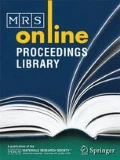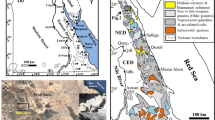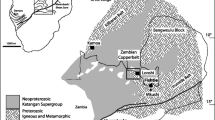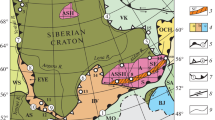Abstract
The Hyrkkölä U-Cu mineralization located in south-western Finland is reassessed with reference to the corrosion mechanisms affecting the stability of native copper and the time-scales of corrosion processes. The mineral assemblage native copper–copper sulfide occurs in open fractures at several depth intervals within granite pegmatites (GP). The surfaces of these open fractures have accumulations of uranophane crystals and other unidentified uranyl compounds. The secondary uranium minerals are mainly distributed around copper sulfide grains. Microscopic intergrowths of copper sulfides and uranyl compounds also have been observed. Groundwater samples were collected from the vicinity of the Cu samples. The hydrogeochemical features of these samples indicate that the present conditions are oxidising. The minimum age of U(VI) transport and deposition is about 200 000 years. This age is indicated by 234U/238U and 230Th/234U activity ratios of uranophane. The age of the hexavalent uranium precipitation may be somewhat later than the last influxes and/or demobilisation of sulfur.
The mineral assemblage native copper–copper oxide (cuprite) occurs only at one depth interval within altered granite pegmatite. The fracture surface was coated by smectite. The content of uranium in smectite was 69–75 ppm U. The 234U/238U and 230Th/234U activity ratios of smectite showed that it has been exposed to recent groundwaters (e.g., during the last million years). The pH of the groundwater at this interval was near neutral (6.9). The copper grains present at this fracture surface were as large as 1 mm in diameter and had rims of cuprite of 0.01 to 0.1 mm thick. The smallest grains were totally oxidised.
Similar content being viewed by others
References
I. N. Marcos, in Scientific Basis for Nuclear Waste Management XX, edited by W.J. Gray and I. Triay, Mat. Res. Soc. Symp. Proc. 465, Pittsburg, PA, 1996, p. 1153–1160.
L. Ahonen, Report YJT-95-19, (1995), (Helsinki, Nuclear Waste Commission of Finnish Power Companies).
M.O. Schwartz, International Geology Review, v. 18, p. 33–44, (1996).
Ö. Amcoff, SKI Report 98:7, (1998).
N. Marcos & L. Ahonen, POSIVA Report 98-xx (to be published).
B. Johanson & K. Kojonen, Geol. Surv. Finland, Special Paper 10, p. 181–184, (1995).
M. Mäkelä & J. Tammenmaa, Report of Investigation, Geol. Surv. Finland. 22p.
N. Yanase, T. Nightingale, T. Payne & P. Duerden. Radiochimica Acta, 52/53, p. 387–393, (1991).
J. Suksi, T. Ruskeeniemi & K. Rasilainen, Radiochimica Acta, 58/59, p. 385–393, (1992).
K.-E. Almén, O. Andersson, B. Fridh, B.-E. Johansson, M. Sehlstedt, E. Gustafsson, K. Hansson, O. Olsson, G. Nilsson, K. Axelsen, and P. Wikberg, SKB Technical Report 86-16, 141 p. (1986).
M. Pósfai & P.R. Busek, American Mineralogist, v. 79, p. 308–315, (1994).
The uranium in samples SM1 and SM2 was selectively extracted by 1. NH4 acetate, 2. NH4 oxalate and the uranium in the residue for 234U/238U activity ratio was extracted by dissolution with HF-HNO3-HCI mixture. The uranium in sample S3 was selectively extracted by 1. Allard water, 2. NH4 acetate, 3. Tamm’s reagent, and then, the uranium fraction for 234U/238U activity ratio was extracted by HNO3 (1M). The meaning of the sequential extraction methods for smectite is discussed in [5,16]. This discussion was not considered to be within the scope of this paper.
P. Lahermo, M. Ilmasti, R. Juntunen, and M. Taka, The Geochemical Atlas of Finland. Part 1. The hydrogeochemical mapping of Finnish Groundwater, Geol. Surv. Finland. 66 p., (1990).
R.W. Potter, Econ. Geol. 72, p. 1524–1542, (1977).
B. Mason, Principles of Geochemistry, John Wiley & Sons, Inc. New York, (1966).
R. Bros, SKB Utveckling Project Report U-98-13, (1998).
Author information
Authors and Affiliations
Rights and permissions
About this article
Cite this article
Marcos, N., Ahonen, L., Bros, R. et al. New Data on the HyrkkÖlÄ Native Copper Mineralization: A Natural Analogue for the Long-Term Corrosion of Copper Canisters. MRS Online Proceedings Library 556, 825 (1998). https://doi.org/10.1557/PROC-556-825
Published:
DOI: https://doi.org/10.1557/PROC-556-825




